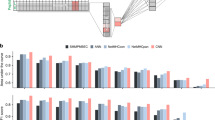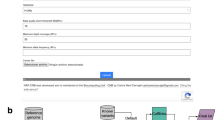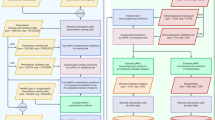Abstract
Tumour-specific neoantigens play a major role for developing personal vaccines in cancer immunotherapy. We propose a personalized de novo peptide sequencing workflow to identify HLA-I and HLA-II neoantigens directly and solely from mass spectrometry data. Our workflow trains a personal deep learning model on the immunopeptidome of an individual patient and then uses it to predict mutated neoantigens of that patient. This personalized learning and mass spectrometry-based approach enables comprehensive and accurate identification of neoantigens. We applied the workflow to datasets of five patients with melanoma and expanded their predicted immunopeptidomes by 5–15%. Subsequently, we discovered neoantigens of both HLA-I and HLA-II, including those with validated T-cell responses and those that had not been reported in previous studies.
This is a preview of subscription content, access via your institution
Access options
Access Nature and 54 other Nature Portfolio journals
Get Nature+, our best-value online-access subscription
$29.99 / 30 days
cancel any time
Subscribe to this journal
Receive 12 digital issues and online access to articles
$119.00 per year
only $9.92 per issue
Buy this article
- Purchase on Springer Link
- Instant access to full article PDF
Prices may be subject to local taxes which are calculated during checkout



Similar content being viewed by others
Data availability
RAW files from ref. 14 were downloaded from the ProteomeXchange repository, accession no. PXD004894. RAW files from ref. 22 were downloaded from the MassIVE repository, accession nos. MSV000084172 and MSV000080527.
Code availability
DeepNovo and the workflow are implemented in Python. The latest version is open source and available on GitHub (https://github.com/nh2tran/DeepNovoAA and https://doi.org/10.5281/zenodo.3988787).
References
Hu, Z., Ott, P. A. & Wu, C. J. Towards personalized, tumour-specific, therapeutic vaccines for cancer. Nat. Rev. Immunol. 18, 168–182 (2018).
Van Allen, E. M. et al. Genomic correlates of response to CTLA-4 blockade in metastatic melanoma. Science 350, 207–211 (2015).
Rizvi, N. A. et al. Mutational landscape determines sensitivity to PD-1 blockade in non-small cell lung cancer. Science 348, 124–128 (2015).
Ott, P. A. et al. An immunogenic personal neoantigen vaccine for patients with melanoma. Nature 547, 217–221 (2017).
Sahin, U. et al. Personalized RNA mutanome vaccines mobilize poly-specific therapeutic immunity against cancer. Nature 547, 222–226 (2017).
Carreno, B. M. et al. A dendritic cell vaccine increases the breadth and diversity of melanoma neoantigen-specific T cells. Science 348, 803–808 (2015).
Andreatta, M. & Nielsen, M. Gapped sequence alignment using artificial neural networks: application to the MHC class I system. Bioinformatics 32, 511–517 (2016).
Jurtz, V. et al. NetMHCpan-4.0: improved peptide-MHC class I interaction predictions integrating eluted ligand and peptide binding affinity data. J. Immunol. 199, 3360–3368 (2017).
Abelin, J. G. et al. Mass spectrometry profiling of HLA-associated peptidomes in mono-allelic cells enables more accurate epitope prediction. Immunity 46, 315–326 (2017).
Bulik-Sullivan, B. et al. Deep learning using tumor HLA peptide mass spectrometry datasets improves neoantigen identification. Nat. Biotechnol. 37, 55–63 (2019).
Bassani-Sternberg, M. & Gfeller, D. Unsupervised HLA peptidome deconvolution improves ligand prediction accuracy and predicts cooperative effects in peptide–HLA interactions. J. Immunol. 197, 2492–2499 (2016).
Bassani-Sternberg, M. et al. Deciphering HLA-I motifs across HLA peptidomes improves neo-antigen predictions and identifies allostery regulating HLA specificity. PLoS Comput. Biol. 13, e1005725 (2017).
Gfeller, D. et al. The length distribution and multiple specificity of naturally presented HLA-I ligands. J. Immunol. 201, 3705–3716 (2018).
Bassani-Sternberg, M. et al. Direct identification of clinically relevant neoepitopes presented on native human melanoma tissue by mass spectrometry. Nat. Commun. 7, 13404 (2016).
Laumont, C. M. et al. Noncoding regions are the main source of targetable tumor-specific antigens. Sci. Transl. Med. 10, eaau5516 (2018).
Cox, J. & Mann, M. MaxQuant enables high peptide identification rates, individualized p.p.b.-range mass accuracies and proteome-wide protein quantification. Nat. Biotechnol. 26, 1367–1372 (2008).
Zhang, J. et al. PEAKS DB: de novo sequencing assisted database search for sensitive and accurate peptide identification. Mol. Cell. Proteomics 11, M111.010587 (2012).
Faridi, P. et al. A subset of HLA-I peptides are not genomically templated: evidence for cis- and trans-spliced peptide ligands. Sci. Immunol. 3, eaar3947 (2018).
Tran, N. H., Zhang, X., Xin, L., Shan, B. & Li, M. De novo peptide sequencing by deep learning. Proc. Natl Acad. Sci. USA 114, 8247–8252 (2017).
Tran, N. H. et al. Deep learning enables de novo peptide sequencing from data-independent-acquisition mass spectrometry. Nat. Methods 16, 63–66 (2019).
Sutskever, I., Vinyals, O. & Le, Q. Sequence to sequence learning with neural networks. Adv. Neural Inf. Process. Syst. 27, 3104–3112 (2014).
Sarkizova, S. et al. A large peptidome dataset improves HLA class I epitope prediction across most of the human population. Nat. Biotechnol. 38, 199–209 (2020).
Vita, R. et al. The Immune Epitope Database (IEDB): 2018 update. Nucleic Acids Res. 47, D339–D343 (2018).
Andreatta, M., Alvarez, B. & Nielsen, M. GibbsCluster: unsupervised clustering and alignment of peptide sequences. Nucleic Acids Res. 45, W458–W463 (2017).
Calis, J. J. A. et al. Properties of MHC class I presented peptides that enhance immunogenicity. PLoS Comput. Biol. 9, e1003266 (2013).
Bassani-Sternberg, M., Pletscher-Frankild, S., Jensen, L. J. & Mann, M. Mass spectrometry of human leukocyte antigen class I peptidomes reveals strong effects of protein abundance and turnover on antigen presentation. Mol. Cell. Proteomics 14, 658–673 (2015).
Keskin, D. B. et al. Neoantigen vaccine generates intratumoral T-cell responses in phase Ib glioblastoma trial. Nature 565, 234–239 (2019).
Acknowledgements
This work was funded in part by the NSERC grant OGP0046506, the Canada Research Chair programme and the National Key R&D Program of China 2018YFB1003202. N.H.T. was supported by the Mitacs Elevate Fellowship. The authors thank K. Pui Choi and J. Xu for critical reading of the manuscript.
Author information
Authors and Affiliations
Contributions
M.L. and B.S. conceived the research idea. N.H.T. designed the neoantigen discovery workflow. N.H.T. and R.Q. implemented the software and analysed the results. X.C. and L.X. contributed to model design, software development and data analysis. N.H.T., M.L. and R.Q. wrote the manuscript. M.L., B.S. and L.X. supervised the research project.
Corresponding authors
Ethics declarations
Competing interests
The workflow in Fig. 1 is the subject of an application for a patent (as a USPTO provisional application by Bioinformatics Solutions Inc., Waterloo, Canada). The authors are named inventors in the patent application. L.X., X.C. and B.S. are employees of Bioinformatics Solutions.
Additional information
Publisher’s note Springer Nature remains neutral with regard to jurisdictional claims in published maps and institutional affiliations.
Extended data
Extended Data Fig. 1 Length distributions of HLA de novo and database peptides.
a, Mel-5 HLA-I; b, Mel-8 HLA-I; c, Mel-12 HLA-I; d, Mel-16 HLA-I; e, Mel-15 HLA-II; f, Mel-16 HLA-II.
Extended Data Fig. 2 Binding affinity of de novo and database HLA-I peptides.
Dashed lines indicate default thresholds of weak-binding (rank 2.0%) and strong-binding (rank 0.5%) of NetMHCpan.
Extended Data Fig. 3
Immunogenicity of de novo and database HLA-I peptides.
Supplementary information
Supplementary Information
Supplementary Figs. 1–6.
Supplementary Table 1
Step-by-step results of our personalized workflow for neoantigen discovery on five patients Mel-5, Mel-8, Mel-12, Mel-15 and Mel-16 from ref. 14. S2: Number of de-novo and database HLA peptides identified at 1% FDR. S3: Peptide-spectrum matches of de-novo HLA peptides at 1% FDR. S4: Performance of the personalized models versus the generic model that was trained on a dataset of 95 HLA-I alleles by Sarkizova and others22. S5: Criteria to select candidate neoantigens from de-novo HLA peptides.
Rights and permissions
About this article
Cite this article
Tran, N.H., Qiao, R., Xin, L. et al. Personalized deep learning of individual immunopeptidomes to identify neoantigens for cancer vaccines. Nat Mach Intell 2, 764–771 (2020). https://doi.org/10.1038/s42256-020-00260-4
Received:
Accepted:
Published:
Issue Date:
DOI: https://doi.org/10.1038/s42256-020-00260-4
This article is cited by
-
Mitigating the missing-fragmentation problem in de novo peptide sequencing with a two-stage graph-based deep learning model
Nature Machine Intelligence (2023)
-
Ad hoc learning of peptide fragmentation from mass spectra enables an interpretable detection of phosphorylated and cross-linked peptides
Nature Machine Intelligence (2022)
-
Computationally instrument-resolution-independent de novo peptide sequencing for high-resolution devices
Nature Machine Intelligence (2021)
-
Deep neural network for detecting arbitrary precision peptide features through attention based segmentation
Scientific Reports (2021)
-
Vaccine Therapies for Cancer: Then and Now
Targeted Oncology (2021)



